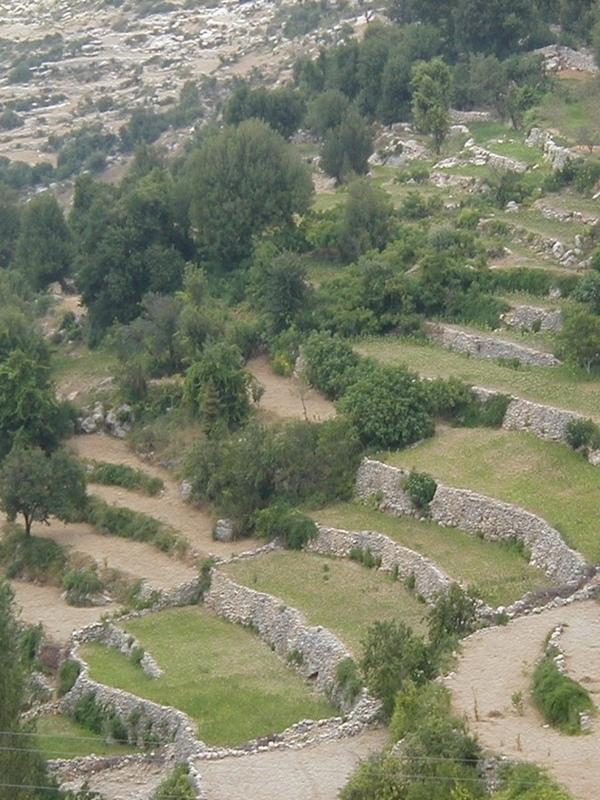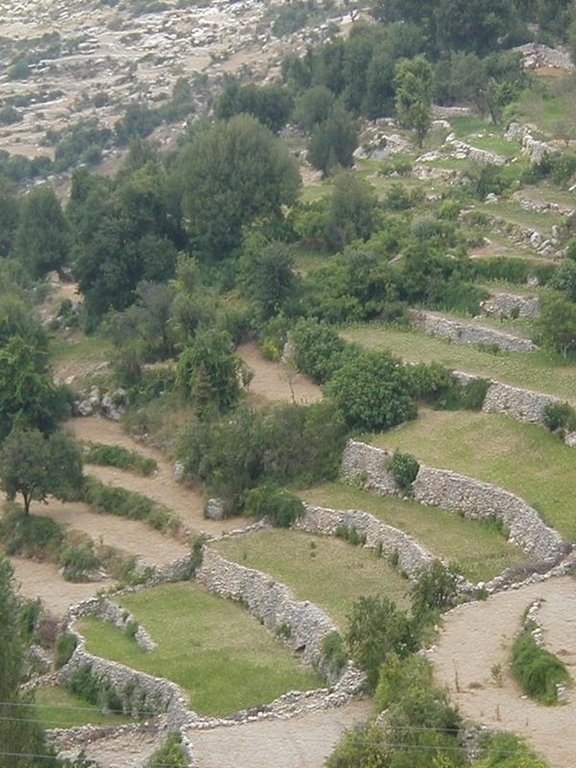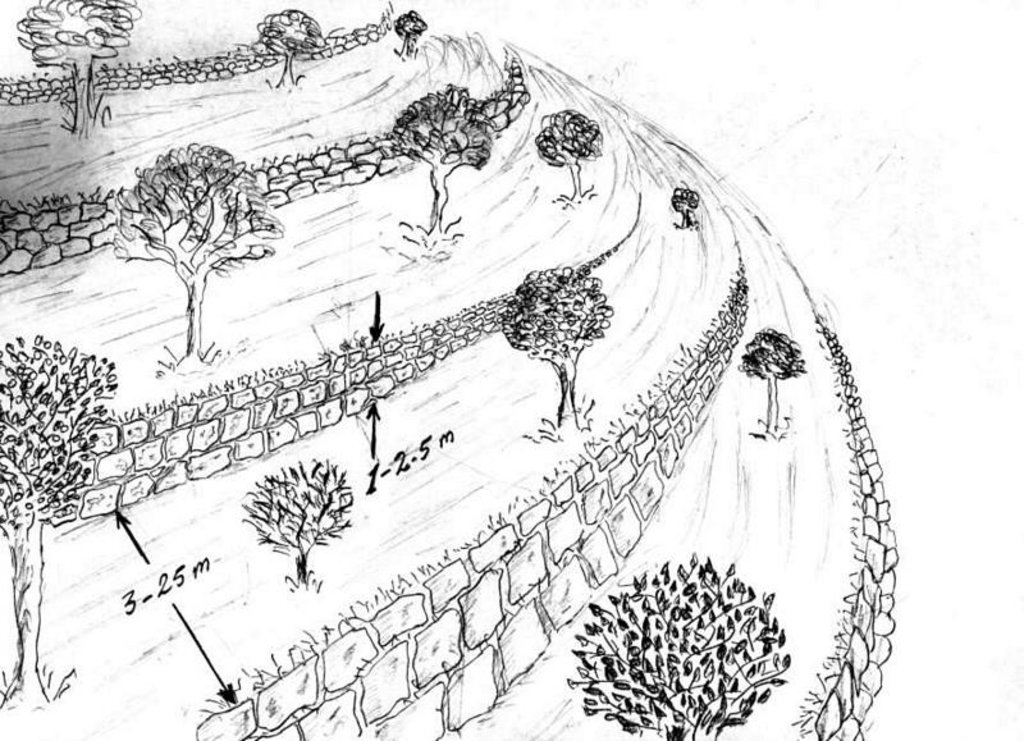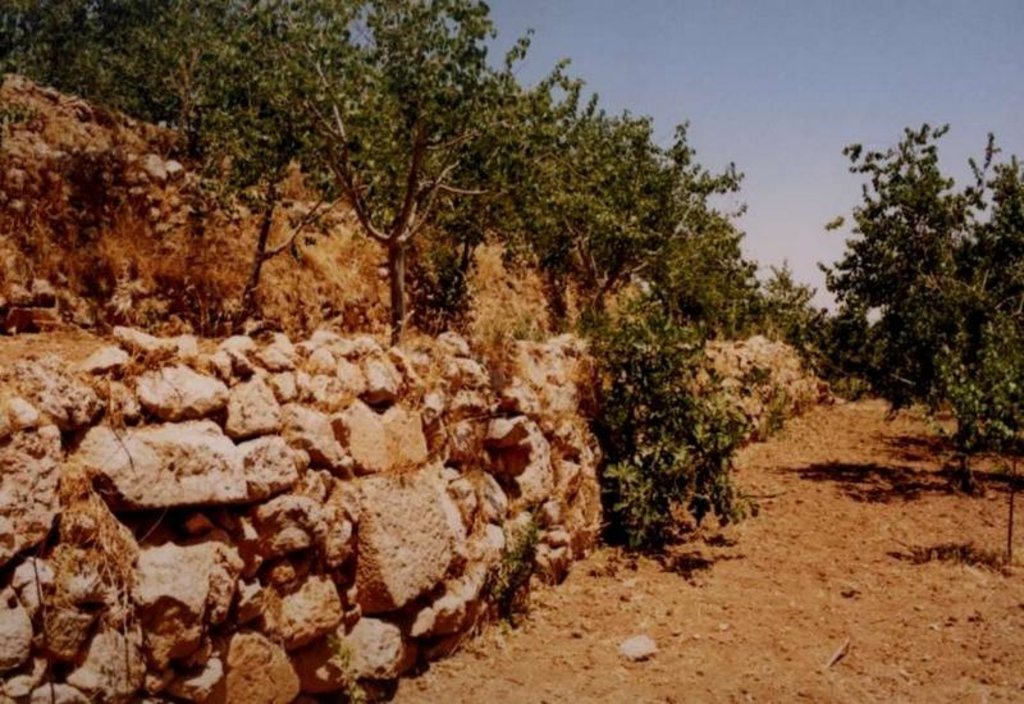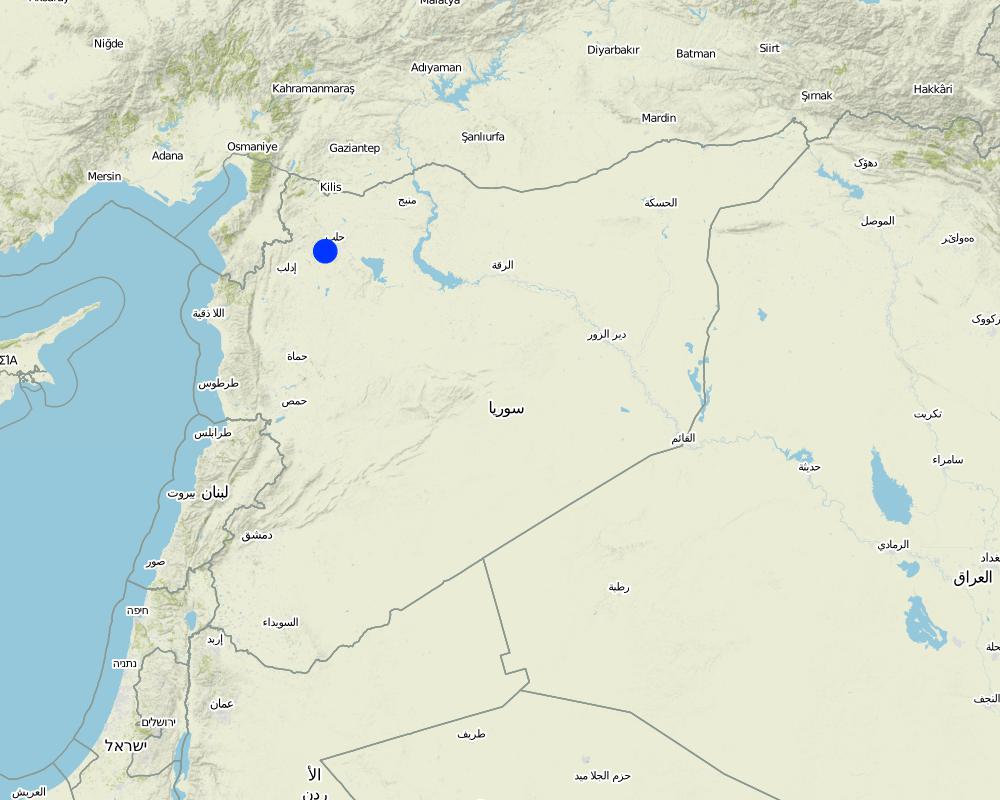Stone Wall Bench Terraces [Syrian Arab Republic]
- Creation:
- Update:
- Compiler: Michael Zoebisch
- Editor: –
- Reviewers: Fabian Ottiger, Alexandra Gavilano
Mudarrajad Hajaria (Arabic)
technologies_1411 - Syrian Arab Republic
View sections
Expand all Collapse all1. General information
1.2 Contact details of resource persons and institutions involved in the assessment and documentation of the Technology
SLM specialist:
SLM specialist:
SLM specialist:
SLM specialist:
SLM specialist:
Salem Salwa
ICARDA Syria
Syrian Arab Republic
Name of project which facilitated the documentation/ evaluation of the Technology (if relevant)
Book project: where the land is greener - Case Studies and Analysis of Soil and Water Conservation Initiatives Worldwide (where the land is greener)Name of the institution(s) which facilitated the documentation/ evaluation of the Technology (if relevant)
International Center for Agricultural Research in the Dry Areas (ICARDA) - Lebanon1.3 Conditions regarding the use of data documented through WOCAT
The compiler and key resource person(s) accept the conditions regarding the use of data documented through WOCAT:
Ja
2. Description of the SLM Technology
2.1 Short description of the Technology
Definition of the Technology:
Ancient level bench terraces with stone walls, built to stabilise slopes, retain moisture, and create a suitable environment for horticulture.
2.2 Detailed description of the Technology
Description:
Stone wall bench terraces in the hill ranges of western Syria comprise an ancient indigenous technology, introduced by the Romans and Byzantines about 2,000 years ago. Some new terraces are, however, still being built. The walls are constructed with limestone, largely found on site. The terraces are located in steep terrain (usually on slopes more than 25%) under low (and erratic) rainfall regimes of between 250 and 500 mm per annum. The terrace walls are 1-2.5 m high and the level beds 3-25 m wide, depending on slope.
Deep soil profiles (more than 2 m) have developed on steep slopes, where original soil depth was only shallow to medium. The terraces are very efficient in preventing soil erosion and in the retention of rainfall. They support trees and annual crops where they could not otherwise be grown.
These terraces are usually found near settlements. Construction is very labour intensive, considering how little land is effectively protected from erosion and brought into cultivation. High labour investment makes the construction process slow and retards further extension of the technology. However, if soundly constructed, maintenance requirements are low. Underlining this point, a large number of very ancient terraces can still be found intact, supporting a productive crop. Sometimes localised collapse of a terrace occurs due to concentrated runoff. In that case, the terrace in question may need to be rebuilt. To prevent such breaches, it is important to allow for discharge of excess runoff along drainage lines.
Currently, most terraces are used to grow fruit trees. These include olives, cherries, almonds, plums, pomegranates, apricots, and peaches. Husbandry practices are normally carried out by hand. Where space permits, however, draft animals are used for tillage. The curves of the terraces and access to the steep slopes make it very difficult/impossible to use tractors. Animal power is more versatile in this irregular landscape, but it is more expensive than tractor power, due to shortage of fodder.
2.3 Photos of the Technology
2.5 Country/ region/ locations where the Technology has been applied and which are covered by this assessment
Country:
Syrian Arab Republic
Region/ State/ Province:
Idleb Province, Ariha District
Further specification of location:
Tal Lata Village
Specify the spread of the Technology:
- evenly spread over an area
If precise area is not known, indicate approximate area covered:
- 1-10 km2
Map
×2.6 Date of implementation
If precise year is not known, indicate approximate date:
- more than 50 years ago (traditional)
2.7 Introduction of the Technology
Specify how the Technology was introduced:
- as part of a traditional system (> 50 years)
Comments (type of project, etc.):
The technology was most probably developed and introduced during the Roman/Byzantine period, 200-400 AD
3. Classification of the SLM Technology
3.1 Main purpose(s) of the Technology
- improve production
- create beneficial economic impact
3.2 Current land use type(s) where the Technology is applied

Cropland
- Tree and shrub cropping
Tree and shrub cropping - Specify crops:
- olive
- stone fruits (peach, apricot, cherry, plum, etc)
- tree nuts (brazil nuts, pistachio, walnuts, almonds, etc.)
- pomegranates
Number of growing seasons per year:
- 1
Specify:
Longest growing period in days: 180 Longest growing period from month to month: Nov - Apr
Comments:
Major land use problems (compiler’s opinion): Before terracing, water erosion resulted in shallow to medium colluvial soils. Terracing made cultivation possible, but the
beds tend to be very narrow and/or irregularly shaped, with large boulders set in them, making tractor cultivation (which is cheap) impossible.
Major land use problems (land users’ perception): (1) Soil tillage - mechanization is difficult; animal power is up to 5 times more expensive than tractor power.
(2) Rockiness of the soil - large and very large stones make cultivation difficult.
(3) Accessibility - inadequate road network to reach fields
3.4 Water supply
Water supply for the land on which the Technology is applied:
- rainfed
3.5 SLM group to which the Technology belongs
- cross-slope measure
3.6 SLM measures comprising the Technology

agronomic measures
- A3: Soil surface treatment
Comments:
Main measures: structural measures
3.7 Main types of land degradation addressed by the Technology

soil erosion by water
- Wt: loss of topsoil/ surface erosion

water degradation
- Ha: aridification
Comments:
Main type of degradation addressed: Wt: loss of topsoil / surface erosion, Ha: aridification
3.8 Prevention, reduction, or restoration of land degradation
Specify the goal of the Technology with regard to land degradation:
- prevent land degradation
4. Technical specifications, implementation activities, inputs, and costs
4.1 Technical drawing of the Technology
Technical specifications (related to technical drawing):
other/ national currency (specify):
Syrian Pounds
If relevant, indicate exchange rate from USD to local currency (e.g. 1 USD = 79.9 Brazilian Real): 1 USD =:
50.0
Indicate average wage cost of hired labour per day:
Author:
Mats Gurtner
4.2 General information regarding the calculation of inputs and costs
other/ national currency (specify):
Syrian Pounds
If relevant, indicate exchange rate from USD to local currency (e.g. 1 USD = 79.9 Brazilian Real): 1 USD =:
50.0
Indicate average wage cost of hired labour per day:
3.00
4.3 Establishment activities
| Activity | Timing (season) | |
|---|---|---|
| 1. | Levelling the terrace bed by bulldozers where necessary. | 0.35-0.7 persondays/m for all activities |
| 2. | Blasting rocks in the field | |
| 3. | Collecting stones for wall building – which are available locally. | |
| 4. | Building the stone walls with 1–2.5 m vertical interval (and therefore | |
| 5. | Levelling land between stone walls. |
4.4 Costs and inputs needed for establishment
| Specify input | Unit | Quantity | Costs per Unit | Total costs per input | % of costs borne by land users | |
|---|---|---|---|---|---|---|
| Labour | Labour | ha | 1.0 | 1260.0 | 1260.0 | 100.0 |
| Labour | Stone collection | ha | 1.0 | 50.0 | 50.0 | 100.0 |
| Equipment | Machine use | ha | 1.0 | 50.0 | 50.0 | 100.0 |
| Equipment | Tools | ha | 1.0 | 50.0 | 50.0 | 100.0 |
| Equipment | Drill | ha | 1.0 | 5.0 | 5.0 | 100.0 |
| Fertilizers and biocides | Ammonium nitrate(kg) | ha | 1.0 | 15.0 | 15.0 | 100.0 |
| Construction material | Stone | ha | 1.0 | |||
| Construction material | Detonators | ha | 1.0 | 10.0 | 10.0 | 100.0 |
| Construction material | Fuses (m) | ha | 1.0 | 20.0 | 20.0 | 100.0 |
| Total costs for establishment of the Technology | 1460.0 | |||||
| Total costs for establishment of the Technology in USD | 29.2 | |||||
Comments:
Duration of establishment phase: 6 month(s)
4.5 Maintenance/ recurrent activities
| Activity | Timing/ frequency | |
|---|---|---|
| 1. | Repairing (replacing stones) | 5 persondays required/every year |
4.6 Costs and inputs needed for maintenance/ recurrent activities (per year)
| Specify input | Unit | Quantity | Costs per Unit | Total costs per input | % of costs borne by land users | |
|---|---|---|---|---|---|---|
| Labour | Labour | ha | 1.0 | 15.0 | 15.0 | 100.0 |
| Equipment | Tools | ha | 1.0 | 5.0 | 5.0 | 100.0 |
| Construction material | Stone | ha | 1.0 | |||
| Total costs for maintenance of the Technology | 20.0 | |||||
| Total costs for maintenance of the Technology in USD | 0.4 | |||||
Comments:
Manual construction work requires 0.35-0.7 person days per metre length of terrace wall. Establishment costs were calculated for an average of 600 m length of stone wall (height 2 m, width 70 cm) per hectare on a 12% slope, with
terrace beds therefore about 16-17 metres wide. Narrower terraces on steeper slopes are considerably more expensive to construct.
4.7 Most important factors affecting the costs
Describe the most determinate factors affecting the costs:
Labour shortage and labour cost
5. Natural and human environment
5.1 Climate
Annual rainfall
- < 250 mm
- 251-500 mm
- 501-750 mm
- 751-1,000 mm
- 1,001-1,500 mm
- 1,501-2,000 mm
- 2,001-3,000 mm
- 3,001-4,000 mm
- > 4,000 mm
Agro-climatic zone
- semi-arid
5.2 Topography
Slopes on average:
- flat (0-2%)
- gentle (3-5%)
- moderate (6-10%)
- rolling (11-15%)
- hilly (16-30%)
- steep (31-60%)
- very steep (>60%)
Landforms:
- plateau/plains
- ridges
- mountain slopes
- hill slopes
- footslopes
- valley floors
Altitudinal zone:
- 0-100 m a.s.l.
- 101-500 m a.s.l.
- 501-1,000 m a.s.l.
- 1,001-1,500 m a.s.l.
- 1,501-2,000 m a.s.l.
- 2,001-2,500 m a.s.l.
- 2,501-3,000 m a.s.l.
- 3,001-4,000 m a.s.l.
- > 4,000 m a.s.l.
Comments and further specifications on topography:
Slopes on average: Also rolling (ranked 3)
5.3 Soils
Soil depth on average:
- very shallow (0-20 cm)
- shallow (21-50 cm)
- moderately deep (51-80 cm)
- deep (81-120 cm)
- very deep (> 120 cm)
Soil texture (topsoil):
- medium (loamy, silty)
- fine/ heavy (clay)
Topsoil organic matter:
- medium (1-3%)
If available, attach full soil description or specify the available information, e.g. soil type, soil PH/ acidity, Cation Exchange Capacity, nitrogen, salinity etc.
Soil fertility: Medium (ranked 1) and low (ranked 2)
Soil drainage/infiltration: Medium
Soil water storage capacity: Medium
5.6 Characteristics of land users applying the Technology
Market orientation of production system:
- mixed (subsistence/ commercial)
- commercial/ market
Off-farm income:
- > 50% of all income
Level of mechanization:
- manual work
- animal traction
Indicate other relevant characteristics of the land users:
Population density: > 500 persons/km2
Annual population growth: 3% - 4%
Relative level of wealth: very rich, rich, average, poor
3% of the land users are very rich and own 20% of the land (very few).
7% of the land users are rich and own 20% of the land (few,).
40% of the land users are average wealthy and own 30% of the land (Many).
50% of the land users are poor and own 30% of the land (Many).
Off-farm income specification: On average, 70 % of the income is from off-farm activities
5.7 Average area of land used by land users applying the Technology
- < 0.5 ha
- 0.5-1 ha
- 1-2 ha
- 2-5 ha
- 5-15 ha
- 15-50 ha
- 50-100 ha
- 100-500 ha
- 500-1,000 ha
- 1,000-10,000 ha
- > 10,000 ha
Comments:
The overall range is 0.5-7 ha
5.8 Land ownership, land use rights, and water use rights
Land ownership:
- individual, titled
Land use rights:
- individual
6. Impacts and concluding statements
6.1 On-site impacts the Technology has shown
Socio-economic impacts
Production
crop production
fodder quality
wood production
land management
Income and costs
farm income
workload
Comments/ specify:
Mechanisation is not possible
Socio-cultural impacts
community institutions
national institutions
conflict mitigation
Comments/ specify:
But a potential for conflict if the community refuses to participate in joint maintenance activities
Ecological impacts
Water cycle/ runoff
excess water drainage
Soil
soil moisture
soil cover
soil loss
nutrient cycling/ recharge
Biodiversity: vegetation, animals
plant diversity
animal diversity
habitat diversity
Climate and disaster risk reduction
wind velocity
6.2 Off-site impacts the Technology has shown
downstream flooding
downstream siltation
groundwater/ river pollution
6.4 Cost-benefit analysis
How do the benefits compare with the establishment costs (from land users’ perspective)?
Short-term returns:
negative
Long-term returns:
positive
How do the benefits compare with the maintenance/ recurrent costs (from land users' perspective)?
Short-term returns:
positive
Long-term returns:
positive
6.5 Adoption of the Technology
If available, quantify (no. of households and/ or area covered):
39
Comments:
5% of land user families have adopted the Technology with external material support
2 land user families have adopted the Technology with external material support
95% of land user families have adopted the Technology without any external material support
37 land user families have adopted the Technology without any external material support
There is no trend towards spontaneous adoption of the Technology
Comments on adoption trend: The rate of spontaneous adoption is low because of the high costs.
6.7 Strengths/ advantages/ opportunities of the Technology
| Strengths/ advantages/ opportunities in the compiler’s or other key resource person’s view |
|---|
|
Soil and water is conserved and fruit crop yields are maintained/increased How can they be sustained / enhanced? Combine with soil fertility improvement (such as farm yard manure). The prices of the crops grown should remain adequate |
|
The maintenance requirements are low. The terraces need little repair How can they be sustained / enhanced? Natural drainage lines must be prepared/maintained to prevent collapse during heavy rainfall. |
| The terraces make the cultivation of trees on hill slopes possible. |
6.8 Weaknesses/ disadvantages/ risks of the Technology and ways of overcoming them
| Weaknesses/ disadvantages/ risks in the compiler’s or other key resource person’s view | How can they be overcome? |
|---|---|
| The establishment costs are high | Plant high value cash crops. |
| The mechanisation of farm operations is impossible because there is no access to the terraces for tractors, while animal power is constrained by high maintenance costs (fodder). Thus, field operations are limited to hand labour | Subsidise mule ploughing. |
7. References and links
7.1 Methods/ sources of information
7.2 References to available publications
Title, author, year, ISBN:
Mushallah AB. The visible and the hidden in the country of olives. pp 463. 2000.
Available from where? Costs?
Akrama Publ. Office. Damascus, Syria.
Links and modules
Expand all Collapse allLinks
No links
Modules
No modules


